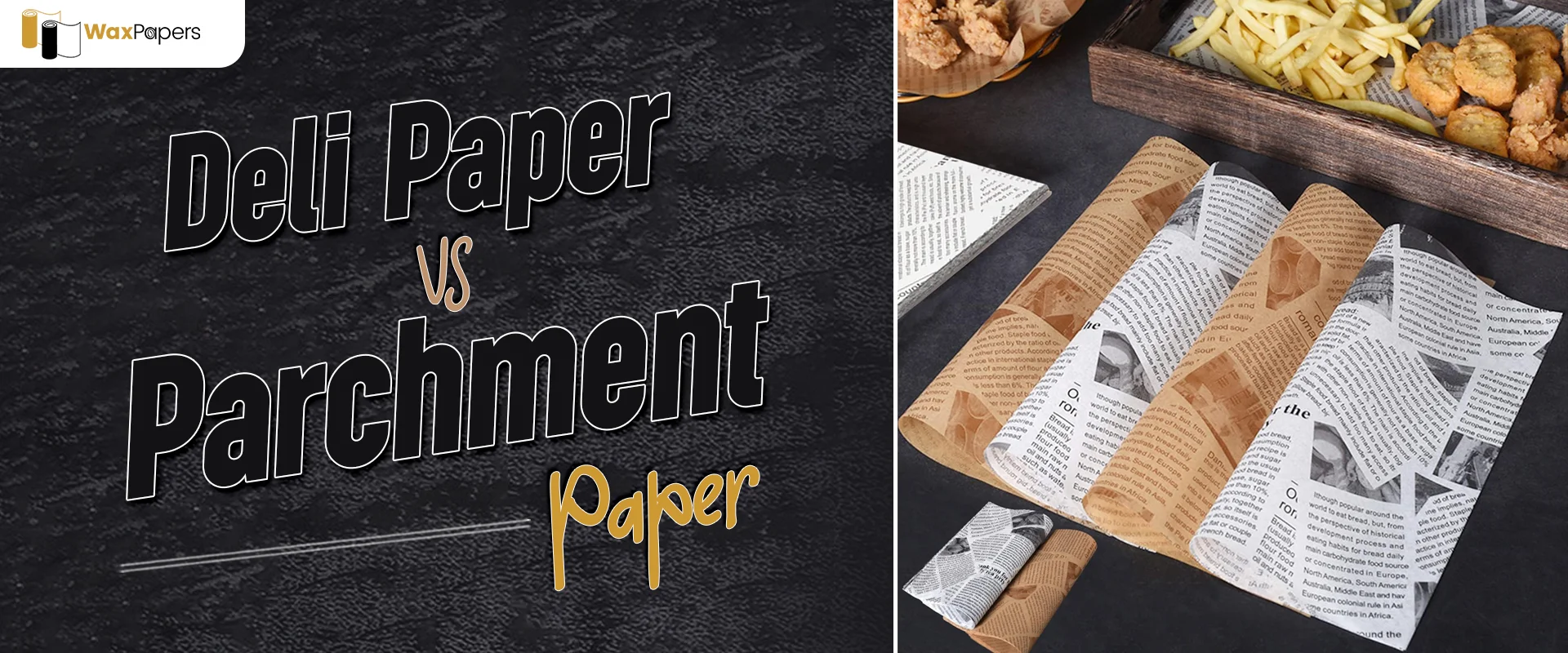Is Deli Paper The Same As Parchment Paper

If you are running a food business then you must be capable enough to differentiate between different types of custom food wrapping papers. The use of the right paper is essential to achieve the desired cooking results. Two commonly used papers in the kitchen are parchment and deli paper which look the same but are significantly different from each other in properties.
The difference in the characteristics of the paper makes them suitable for different applications. Resistance to heat and moisture, thickness, coatings, material composition, chemical treatment, and longevity are some of the major differences in both custom papers. To comprehensively understand the differences let’s read the blog.
What Is Deli Paper?
Custom printed deli paper is light in weight and has a wax or PE coating. This paper is used to wrap sandwiches, burgers, and various other edible items people consume on a daily basis. This custom paper has non-stick properties which is why you can use it like food trays, cover countertops, and wrap food. The paper is permeable to grease so you can wrap your food that is high in fat content and prevent mess.
What Is Parchment Paper?
Custom parchment paper is relatively thick from deli sheets and is highly resistant to heat. You can use this paper to line baking pans and bake your food easily. As the paper is non-stick you can use it for rolling dough, baking cookies, and roasting vegetables without the need for excessive oil. 450°F (232°C) is the maximum temperature that it can tolerate which is why it can be used in ovens.
Major Differences
All the custom food wraps have the same appearance, nonetheless, they are quite distinct from each other, say greaseproof paper vs wax paper, both have the same white colors but the key properties are way much different from each other. Similar to this, custom deli paper for restaurants and parchment has similar looks but different purposes and properties. Below are some of the key differences that you can observe between the two.
| Property | Deli Paper | Parchment Paper |
| Material | This paper is made with bleached or unbleached paper | This paper is made from wood pulp and is treated with sulphuric acid to increase its heat resistance |
| Coating | It contains wax, PE, or grease-resistant coating | Typically silicone-coated or uncoated (for non-stick properties). |
| Use | Primarily for wrapping and serving food. | You can use the paper to bake, cook, and as a non-stick liner |
| Heat Resistance | It has moderate resistance to heat therefore cannot be used in the ovens. | It is heat-resistant as its temperature tolerance is 450°F (232°C). |
| Non-Stick Properties | Often not non-stick unless waxed or coated. | Non-stick due to silicone coating, making it ideal for baking. |
| Absorbency | Absorbent to some extent, especially for grease. | Not very absorbent, and repels oils and liquids. |
| Cost | Generally cheaper and thinner. | More expensive due to its specialized, heat-resistant properties. |
When to Use Deli Paper
Custom deli paper is manufactured for casual usages such as food presentation, storage, and wrapping. As the paper is less durable than that of parchment that is why it can’t be used in the ovens because the chances of catching fire are high. You can use it for the following purposes:
- Sandwich and Wrap Wrapping
- Food Service and Takeout
- Serving at Parties or Buffets
- Non-Heat Applications
When To Use Parchment Paper
Comparing deli paper vs parchment paper, the latter is much more versatile. Parchment paper roll is one of the versatile kitchen tools. Due to its high resistance to temperature and grease, it is used for baking and cooking. You can use parchment paper sheets for the following purposes:
- Baking
- Roasting
- Rolling Dough
- Food Preparation
- Short-term food storage in the freezer
| Use Case | Deli Paper | Parchment Paper |
| To Wrap | You can wrap your sandwiches, burgers, rolls, etc | Not typically used for wrapping food; may tear. |
| Baking | Not suitable for baking; will burn at high temperatures. | Perfect for lining baking sheets and pans. |
| Roasting | No | Yes |
| Non-Stick Cooking | No | Highly non-stick |
| Takeout and Serving | Excellent for takeout orders, serving, and food presentation. | Not commonly used for serving food in a casual setting. |
| Temperature Resistance | Cannot withstand high temperatures; not oven-safe. | Heat-resistant up to 450°F (232°C), perfect for oven use. |
Purpose of Understanding The Difference
It is crucial to understand the difference between custom deli paper sheets and parchment paper because without this understanding you can not cook and present your ideas effectively. Using deli paper at high temperatures can prove highly dangerous as the wax coating on wax deli paper may catch fire. On the other hand, using parchment paper to wrap food on a regular basis can prove noticeably expensive as this paper is costly. You must know what freezer paper vs parchment paper, butcher paper vs parchment paper, and so on to know what is the best option for you.
Conclusion!
Custom deli and parchment both papers are different from each other not only in features, but they are different in applications too. The only common thing in both of them is that, if coated with wax, both the papers are compostable, and you can use them if you are looking for an alternative to unsustainable cling paper. From Waxpapers you can get any kind of custom food wrap and make your food presentation and cooking easy at affordable rates!


